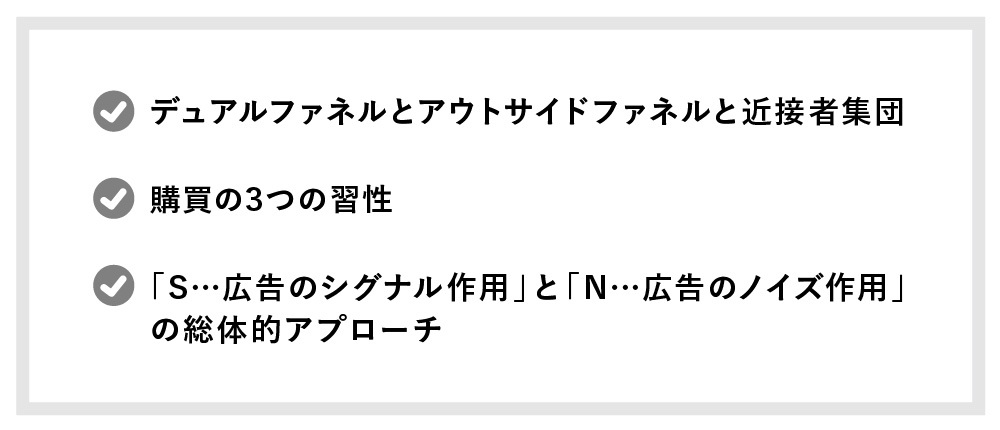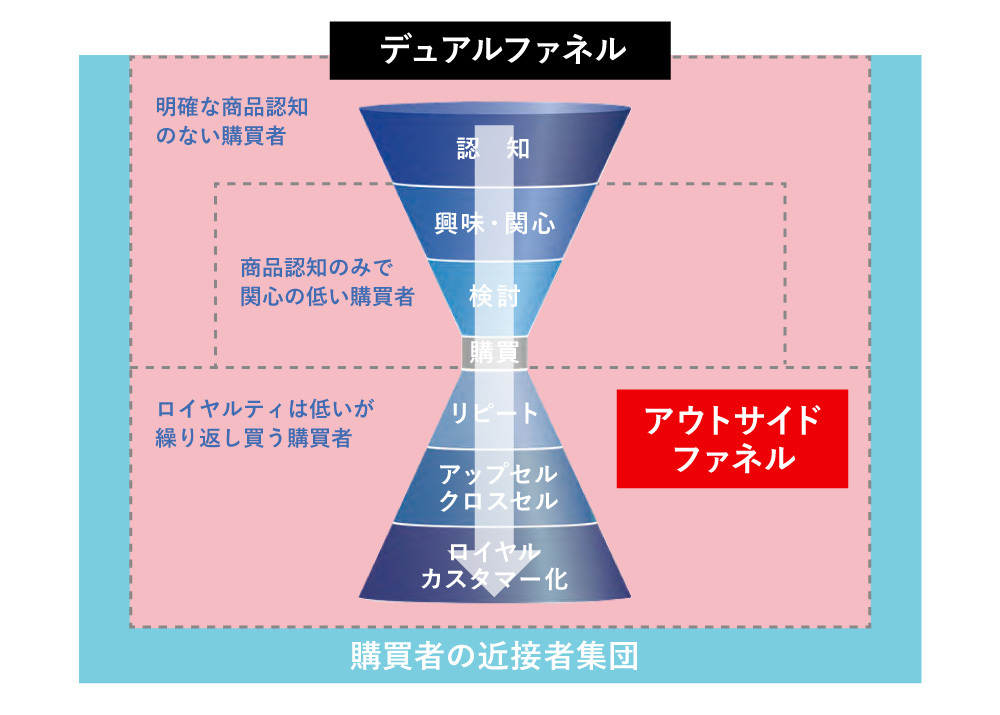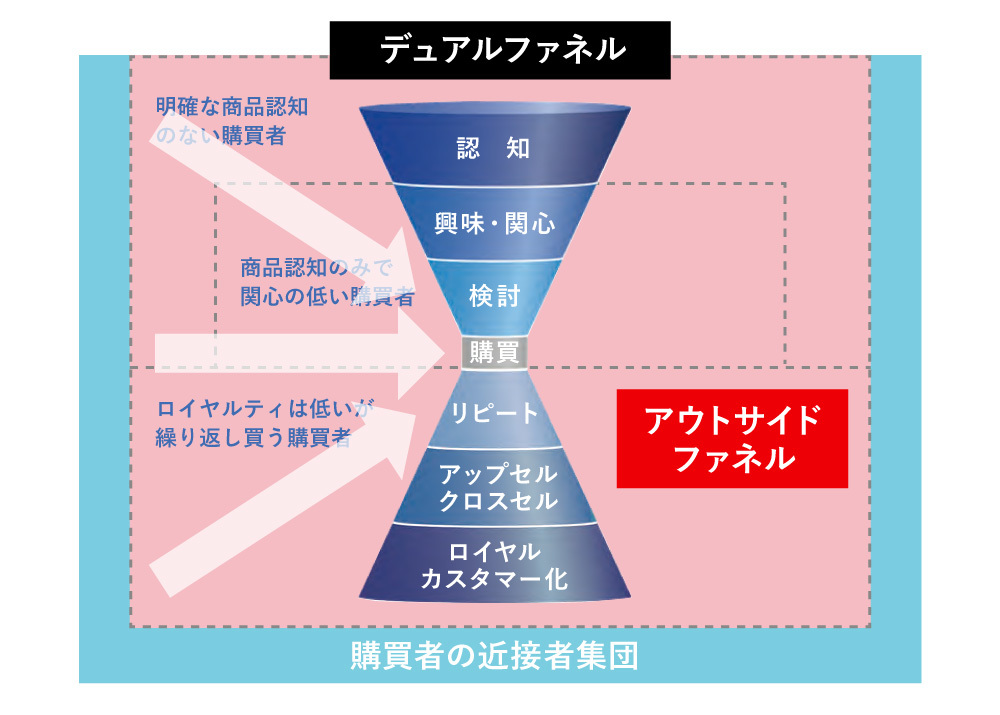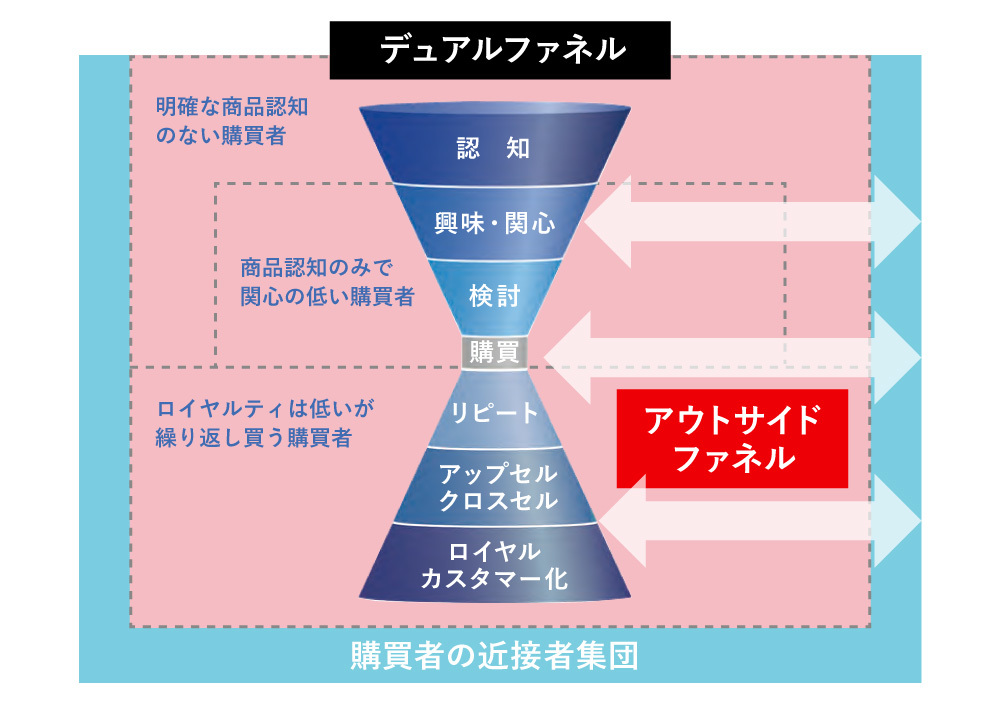Behind every purchase lie three key habits!
<Table of Contents>
▼Unraveling the Triggers for "Buying" Through "Three Habits"
▼① Reinforcement Habit = Gathering Reasons to Buy
▼② Omission Habit = Unconscious Product Selection
▼③ Conformity Habit = Wanting Something Because Others Mention It
▼The Three Habits Revealed by the Blockbuster Movie "Demon Slayer: Mugen Train"
▼Differences in Habits Across Product Categories
Unraveling the triggers of "buying" through "three habits"
Last time, we introduced the new market structure discovered by Dentsu Inc. internal cross-departmental "SN Project Team(※)" through a behavioral economics perspective on "how people buy things."
※ = SN Project Team
This is an internal cross-departmental research team comprising experts from Dentsu Inc.'s Marketing, Data Solutions, and Media divisions. "SN" was named after the core research findings: "Signal/Noise Effects of Advertising."
To briefly recap, the market structure formed by product sales can be broadly divided into the following three areas:
Dual Funnel
The core domain of marketing activities that "increase customer interest in the product"
Outside Funnel
The area containing consumers who purchase products despite having low interest in the product or category.
Proximity Group
A group that creates opportunities for products to enter the consideration set through word-of-mouth and conversations, influencing both ① the Dual Funnel and ② the Outside Funnel
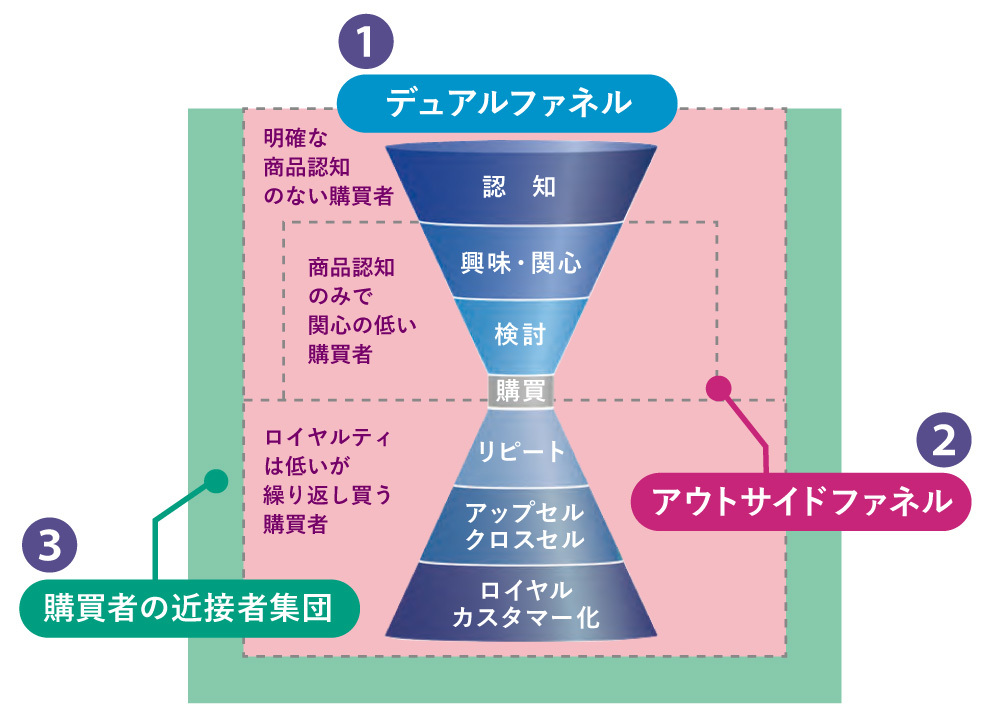
This time, we will explore what psychological and behavioral triggers prompt people in these three market segments to make purchases.
The "SN Theory Keywords" section below introduces the second part: "Three Habits of Purchase."
"Three Habits" ① Reinforcement Habit = Gathering Reasons to Buy
The first habit is the "Reinforcement Habit." This refers to the tendency to seek out information that resonates with you or suits your convenience, thereby strengthening your own reasons for buying. In other words, it means acquiring reasons to buy before purchasing the product.
For example, when choosing clothes or brands you're interested in at a clothing store, you've probably had experiences like listening to sales staff at the store or asking family, friends, or partners for their opinions.
We interpret these actions as reinforcing behaviors—specifically, the "reinforcement habit"—that occur when you have interest or purchase intent for a product, serving to solidify your reasons for buying.
Other examples include searching for product reviews or comparing multiple products, which also fall under reinforcement behavior. We believe this reinforcement behavior primarily functions to enhance the efficiency of dual-funnel marketing.
"Three Habits" ② Omission Habit = Unconscious Product Selection
Next is the "Omission Habit." This refers to the tendency to unconsciously set a threshold for "acceptable purchases" to reduce the effort required for decision-making.
For example, recall standing in front of a convenience store's beverage shelf to buy water. While you might spend a few seconds considering which brand to choose, you likely don't look at, recognize, and evaluate every single product on the shelf.
Instead, you likely prioritize recognizing and picking up items you've "tried before," "seen before," or "trusted brands." We define this habit of narrowing down choices unconsciously before purchasing as the "omission bias."
Surveys examining purchase reasons by category also show that the percentage of people who buy products somewhat randomly is higher for repeat purchases than for initial purchases. This omission bias is thought to strengthen among repeat buyers.

"Items that enter the field of vision at the moment of purchase" are pre-set in memory, reducing the cost of product selection. We believe this habit significantly influences action prompts and the creation of purchase opportunities, particularly for consumers in the outside funnel.
"Three Habits" ③ Conformity Habit = Wanting What Everyone Talks About
Finally, the "Conformity Habit." This refers to the tendency where information shared within a close-knit group (family, friends, or social media followers) lowers barriers to purchase or stimulates buying activity.
Information shared within these close-knit groups serves two primary functions.
The first function is "reducing the communication costs required when purchasing a product."
For example, a child who wants the latest game console likely doesn't have the purchasing power themselves and will ask their parents.
In such cases, rather than simply asking, starting the conversation with a shared reference like "that product I saw on TV" or "that product we saw together in the store" eliminates the need to gather new information about the product, making it easier to get the purchase approved.
The second function is that "the shared information itself becomes a basis for purchase decisions."
For example, if all your friends are talking about the same game, the more they get excited about this shared topic, the more interest you develop in something you initially had little interest in. This can strengthen your desire to have it, leading you to purchase the product.
We define this tendency, where purchasing decisions are shaped by information shared by one's immediate circle, as the "conformity tendency." This tendency is not limited to connections in real life but can also arise from connections and information sharing with a large, undefined group of people, such as on social media.
Three Habits Revealed by the Huge Hit Movie "Demon Slayer: Kimetsu no Yaiba - Mugen Train Arc"
It is crucial to develop planning that holistically integrates these three behaviors: reinforcement behavior that boosts Dual Funnel Marketing efficiency, omission behavior that stimulates purchases and creates buying opportunities in the Outside Funnel, and conformity behavior that creates and activates spaces for information sharing among close associates.
The record-breaking hit movie "Demon Slayer: Kimetsu no Yaiba the Movie: Mugen Train" is considered a prime example of successfully integrating these three habits.
The broadcast of the anime series on terrestrial TV excited core anime and manga fans, strengthening reinforcement habits.
Furthermore, multiple reports of the film's massive success triggered the omission tendency, making it easier for those with low interest in anime to choose to watch.
Furthermore, the voice actors' TV appearances and the buzz on fans' social media sparked conversations in everyday life, invigorating the conformity habit. In this way, the relationship between media stimulation and these three habits is thought to have led to the film "Demon Slayer" becoming a massive hit, exceeding approximately 40 billion yen in domestic box office revenue.
Differences in Habits Across Product Categories
Next, we explain the differences in habits across product categories.
The graph below plots differences in user interest levels across product categories and differences in brand differentiation within categories on two axes, based on Dentsu Inc.'s proprietary survey. Additionally, based on survey questions about purchase selection reasons, each category is color-coded to indicate which habit it corresponds to.
The "brand difference" here indicates whether consumers perceive differences in product features or taste between brands. For coffee, it reflects whether consumers believe there is a significant difference between buying Product A or Product B. If differences exist, it is labeled "Large Brand Difference"; if not, "Small Brand Difference."

Looking at these results, for example, "smartphone payments" show relatively high interest in the service itself, likely due to the recent cashless trend. However, we can see that brand difference is not significant.
While "smartphone payments" are used for in-store purchases, they also facilitate money transfers between friends. Service choice often depends on which payment services people around you use. Consequently, brand differences are small, and this behavior likely falls under "conformity tendency," where purchasing habits are easily influenced by the immediate peer group.
Grouping by each habit yielded the following results:
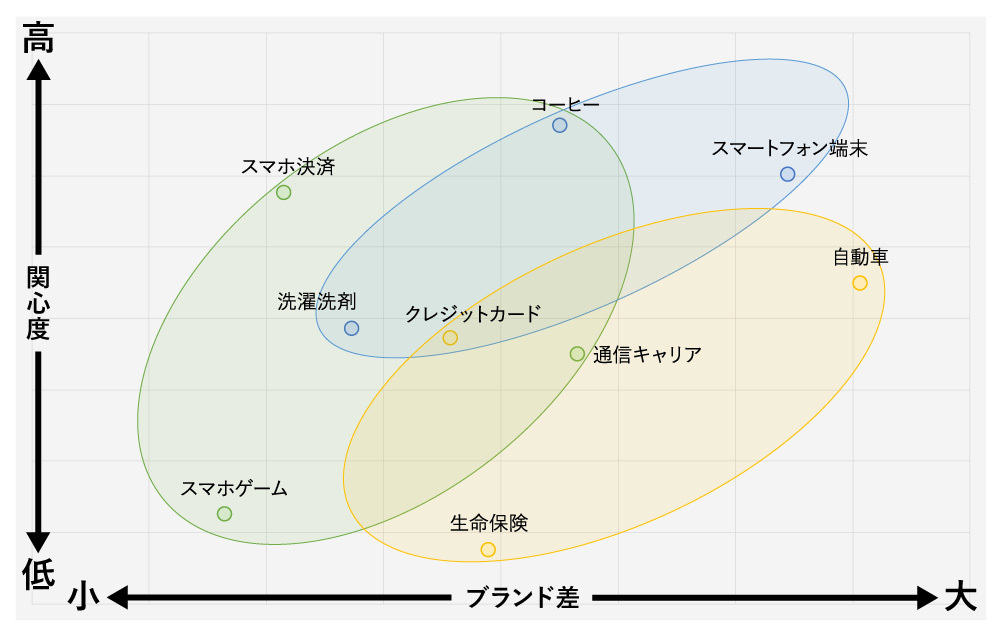
To summarize the trends simply:
Reinforcement Habit
[Interest Level: Low to Moderate, Brand Difference: Moderate to Large]
Given the significant brand differences, it can be interpreted that consumers tend to research desired products beforehand or seek sales staff opinions in stores, incorporating information that suits their needs before purchasing.
Omission Habit
[Interest Level: Medium to High, Brand Difference: Medium to Large]
With both high interest and significant brand differences, purchases tend to be influenced by the brand's perceived reliability and familiarity.
【Interest Level: Low to Medium, Brand Difference: Small to Medium】
With smaller brand differences, consumers are more influenced by those around them—what others choose or use.
As shown, purchasing habits vary depending on the category's position in society—factors like the level of interest in the category itself and the differences between brands.
Furthermore, as evident from the grouping results above, these three purchasing habits likely overlap and interact to influence buying decisions.
When considering your company's product, where would it be plotted? It's essential to understand the product's position—not just its features, but its standing in terms of overall interest within society—to grasp its purchasing behavior and devise the next strategic move.
So, how does "advertising" as the next strategic move impact users? Next time, we'll address this question from the perspective of "advertising's signaling effect and noise effect."
[Survey Overview]
Survey Name: Survey on Purchase Reasons by Category
Survey Period: July 19, 2021 - July 25, 2021
Area: Kanto Region (Tokyo and six prefectures)
Sample Size: 4,000 respondents
Note: Surveyed 20 brands across 7 FMCG categories
Survey Title: Survey on Interest Levels and Brand Differences by Category
Survey Period: March 9, 2022 - March 14, 2022
Area: Nationwide
Sample Size: 2,400 respondents (ages 20–69, male and female)
Was this article helpful?
Newsletter registration is here
We select and publish important news every day
For inquiries about this article
Author

Shota Tsukada
Dentsu Inc.
Since joining the company, I have worked in the Data Marketing Division, participating in projects for clients across a wide range of industries. My primary responsibilities include driving media planning and PDCA effectiveness measurement utilizing STADIA television viewing log data, while also expanding my scope to encompass DMP platform development and solving clients' business challenges.
